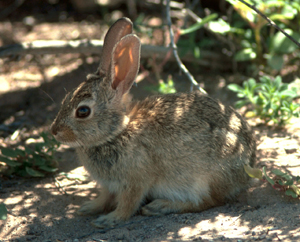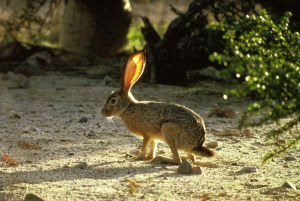Rabbits
Rabbit was one of the most important animals to the native peoples of the Trans-Pecos. As the climate of the Trans-Pecos became warmer and drier over time, large mammals, such as deer and antelope, became scarcer in the lowlands. This forced native peoples to rely more heavily on smaller mammals, namely rabbit, for meat. Rabbit fur was also an important resource that could be made into robes, blankets, or other winter clothing. Even rabbit bones could be cut into short lengths to make beads.
The native peoples of the Trans-Pecos preyed primarily on black-tailed jackrabbit (Lepus californicus) and desert cottontail (S. audubonii) which can be found throughout the region, and occasionally took eastern cottontail (Sylvilagus floridanus), which is confined to the cooler, wetter environments of the mountains. To catch rabbits, hunters usually threw wooden “rabbit sticks” at the animals to kill or immobilize them. Groups of hunters sometimes participated in “rabbit drives” by stretching a net across a gully, or other low terrain, then driving rabbits toward it so that they could be dispatched with clubs or rabbit sticks.
Virtually every site in the Trans-Pecos with preserved animal bones contains the remains of rabbit, and at many sites rabbit dominates the faunal assemblage. Rabbit sticks have been recovered from dry rockshelters, such as Granado Cave and Bee Cave Canyon. Early Spanish explorers’ accounts also name rabbit as an important food source for the native peoples they encountered.

|
